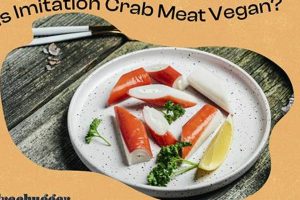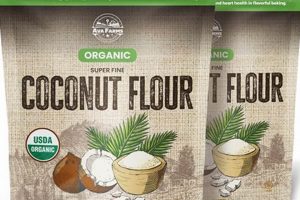Plant-based gelatin alternatives constitute a distinct category within the broader confectionery and dessert sector. These products replicate the textural properties of traditional gelatin-based desserts, utilizing ingredients derived from plants instead of animal collagen. Carrageenan, agar-agar, and plant-based gums are commonly employed to achieve the desired gelling effect. An example includes fruit-flavored desserts created without any animal-derived components.
The creation and consumption of such desserts address concerns related to animal welfare and dietary restrictions. They broaden the range of dessert options available to individuals adhering to vegan lifestyles, religious dietary guidelines, or those seeking to reduce their consumption of animal products. Historically, the development of these alternatives marks a significant shift towards inclusivity and sustainability in the food industry, meeting evolving consumer demands and ethical considerations.
Further examination will encompass the specific ingredients employed in these plant-derived gels, a comparative analysis of their gelling properties, and an assessment of their environmental impact. The market trends and consumer perceptions associated with this product category will also be addressed in subsequent sections.
Guidance on Plant-Based Gelatin Alternatives
The following guidelines offer critical insights for individuals seeking to understand, utilize, or create desserts relying on plant-derived gelling agents. These recommendations are based on established culinary principles and scientific understanding of hydrocolloids.
Tip 1: Ingredient Selection: Thoroughly examine the properties of each gelling agent. Agar-agar, carrageenan, and plant-based gums exhibit distinct gelling strengths and textural outcomes. Select the ingredient best suited to the desired final product characteristics.
Tip 2: Hydration Protocols: Adhere strictly to the recommended hydration protocols for each agent. Incomplete hydration can result in grainy textures or diminished gelling capacity. Boiling agar-agar, for example, is typically required to activate its gelling properties.
Tip 3: Concentration Considerations: Adjust the concentration of the gelling agent according to the presence of other soluble solids in the recipe. Higher sugar concentrations or acidic conditions may necessitate adjustments to maintain optimal gel formation.
Tip 4: Temperature Control: Precise temperature control is critical during the gelling process. Rapid cooling can lead to undesirable textures, while excessively slow cooling may prevent proper gel formation. Maintain consistent refrigeration temperatures for optimal results.
Tip 5: Acidity Adjustments: Certain plant-based gelling agents are sensitive to acidity. Excessive acidity can inhibit gel formation. Buffer ingredients or adjust pH levels accordingly to ensure successful gelation.
Tip 6: Experimentation and Documentation: Employ systematic experimentation to refine recipes and understand the interaction between ingredients. Meticulous documentation of ingredient ratios, processing parameters, and resulting textures is crucial for replicable outcomes.
These recommendations emphasize the importance of informed decision-making and precise execution when working with plant-based gelatin alternatives. Adherence to these principles will enhance the likelihood of achieving desired textural properties and product consistency.
Further research into specific applications, such as the creation of vegan-compatible candies or savory gels, will be presented in subsequent sections of this discourse.
1. Plant-based origins
The foundational characteristic of products marketed as plant-based gelatin alternatives is their derivation from non-animal sources. This attribute directly addresses the core tenets of veganism and dictates the composition and production methodologies employed.
- Source Material Selection
The selection of appropriate source materials is paramount. Agar-agar, derived from seaweed, and carrageenan, extracted from red algae, are prevalent examples. Plant-based gums, such as gellan gum, are produced via microbial fermentation. The chosen source material significantly influences the gelling properties, clarity, and overall texture of the finished product.
- Extraction and Processing Techniques
Extraction methods vary depending on the source material. Agar-agar typically involves boiling seaweed to release the gelling agent, followed by filtration and drying. Carrageenan extraction involves alkaline treatment and precipitation. These processes must be carefully controlled to ensure purity and maintain the integrity of the gelling agent. Minimal processing is often favored to retain the inherent qualities of the source material.
- Absence of Animal-Derived Ingredients
A defining feature of these products is the complete absence of animal-derived ingredients, including gelatin, which is derived from animal collagen. Rigorous sourcing and manufacturing protocols are implemented to prevent cross-contamination and ensure adherence to vegan standards. This commitment to animal-free production is a central tenet of the product category.
- Impact on Allergenicity
Plant-based origins often mitigate the risk of certain allergens associated with animal products. However, potential allergens related to the specific plant source, such as seaweed or soy-derived ingredients, must be carefully considered and clearly labeled. Allergen management is a critical aspect of product development and consumer safety.
The emphasis on plant-based origins extends beyond simple ingredient substitution; it represents a commitment to ethical sourcing, sustainable production, and dietary inclusivity. This foundational principle shapes the identity and market positioning of plant-based gelatin alternatives.
2. Textural Similarities
Achieving textural parity with traditional gelatin-based products is a primary objective in the development of plant-derived gelled desserts. The success in replicating characteristic mouthfeel and structural integrity significantly influences consumer acceptance and market viability.
- Elasticity and Firmness
Gelatin exhibits characteristic elasticity and firmness attributed to its collagen-based structure. Plant-based alternatives strive to emulate these properties through the careful selection and manipulation of hydrocolloids. Achieving the desired firmness without compromising elasticity is a critical balancing act, often requiring blends of different gelling agents. For instance, carrageenan might provide firmness, while locust bean gum contributes to elasticity.
- Melt-in-the-Mouth Sensation
The controlled release of flavor and a smooth, melt-in-the-mouth sensation are desirable textural attributes. Gelatin-based desserts typically exhibit these qualities due to the thermo-reversible nature of gelatin. Plant-based gels aim to replicate this sensation through appropriate gelling agent selection and careful manipulation of ingredient ratios. Achieving a clean release of flavor without any lingering aftertaste is a key consideration.
- Clarity and Translucency
Visual appeal is an important factor in consumer perception. Traditional gelatin desserts often possess a high degree of clarity and translucency. Certain plant-based gelling agents, such as agar-agar, can achieve comparable levels of clarity, enhancing the aesthetic appeal of the final product. Filtration and purification processes play a crucial role in minimizing cloudiness and maximizing translucency.
- Stability and Syneresis Control
Maintaining textural stability over time and preventing syneresis (water expulsion) are essential for product longevity and consumer satisfaction. Gelatin effectively binds water, preventing excessive weeping. Plant-based alternatives require careful formulation to achieve comparable water-binding capacity and minimize syneresis during storage. The addition of stabilizers, such as gums, can improve water retention and extend shelf life.
The pursuit of textural similarities underscores the technical challenges and innovative solutions within the plant-derived gelled dessert category. The successful replication of gelatin’s textural attributes expands the accessibility and appeal of these products to a broader consumer base, fostering increased adoption and market growth.
3. Gelatin Replacement
The concept of gelatin replacement is central to the production and consumption of plant-derived gelled desserts. It addresses the need for a functional and structurally analogous substitute for animal-derived gelatin, enabling the creation of products that align with vegan dietary principles and ethical considerations. The efficacy of gelatin replacement directly impacts the quality, acceptance, and market penetration of such products.
- Hydrocolloid Functionality
Hydrocolloids, such as agar-agar, carrageenan, and pectin, serve as the primary agents of gelatin replacement. These substances possess the inherent ability to form gels in aqueous solutions, mimicking the structural properties of gelatin. The specific hydrocolloid or blend thereof is selected based on its gelling strength, clarity, and compatibility with other ingredients in the formulation. The choice impacts the final texture and stability of the product. For example, agar-agar provides a firm, brittle gel suitable for some applications, while carrageenan yields a more elastic texture preferred in others.
- Source Material Diversification
Gelatin is derived from animal collagen. Replacement strategies necessitate the exploration and utilization of diverse plant-based and microbial sources. Seaweed, fruits, and bacterial fermentation provide the raw materials for hydrocolloids used as gelatin alternatives. Source material diversification reduces reliance on animal products and expands the range of potential gelling agents. Pectin, derived from fruit peels, offers a sustainable and readily available alternative in certain applications. Gellan gum, produced by bacterial fermentation, exhibits unique gelling properties applicable to a variety of dessert formats.
- Textural Mimicry and Modification
Achieving textural similarity to gelatin-based desserts is a crucial aspect of successful replacement. However, direct substitution is not always feasible or desirable. Plant-based gelling agents often exhibit distinct textural characteristics that require careful manipulation to achieve the desired outcome. Formulators may employ blends of different hydrocolloids, adjust concentrations, or modify processing parameters to replicate or enhance the textural attributes of traditional gelatin desserts. The goal is to provide a product that is both palatable and structurally sound.
- Ethical and Dietary Alignment
Gelatin replacement directly addresses ethical and dietary concerns associated with animal-derived products. The utilization of plant-based and microbial sources aligns with vegan, vegetarian, and religious dietary guidelines. This alignment expands the market reach of gelled desserts and caters to consumers seeking ethically sourced and sustainable food options. Gelatin replacement is not merely a technical substitution but a conscious choice driven by ethical and dietary considerations.
The implementation of gelatin replacement strategies in plant-based desserts extends beyond simple ingredient substitution. It entails a comprehensive understanding of hydrocolloid functionality, source material diversification, and textural modification techniques. The successful execution of these strategies enables the creation of products that are both ethically sound and aesthetically pleasing, further solidifying the position of vegan gelled desserts within the broader confectionery market. Further research and development continue to refine these techniques and explore novel gelling agents, pushing the boundaries of what is possible in the realm of plant-based dessert creation.
4. Dietary Suitability
The relationship between dietary suitability and plant-derived gelled desserts is characterized by inherent compatibility. These products address a specific need within various dietary regimens, providing options that align with established guidelines. A primary example is the adherence to vegan principles, which preclude the consumption of animal-derived substances, including conventional gelatin. The availability of plant-based gels broadens the scope of dessert choices for individuals following this dietary framework. Further examples encompass religious dietary laws, such as those prohibiting porcine-derived gelatin, and medically restricted diets where specific animal proteins may be contraindicated. The design and formulation of plant-derived gels, therefore, consider dietary restrictions as a core determinant of product composition.
The practical significance of dietary suitability is evident in the growing demand for these alternatives within the food service industry and retail market. Restaurants and food manufacturers increasingly offer plant-based gel options to cater to diverse consumer preferences and dietary needs. Accurate labeling and transparent ingredient sourcing are critical components in ensuring dietary compliance. Real-world examples include the development of kosher-certified and halal-certified plant-based gels, specifically formulated to meet religious dietary standards. Furthermore, nutritional considerations, such as sugar content and allergen information, are factored into the design of these products to maximize their applicability across a wider spectrum of dietary needs. The result is a more inclusive and accessible dessert category.
In summary, the inherent dietary suitability of plant-derived gelled desserts is a key driver of their market growth and acceptance. These products directly address the limitations imposed by various dietary restrictions, offering viable alternatives to traditional gelatin-based options. However, challenges remain in terms of maintaining textural consistency and optimizing nutritional profiles. Ongoing research and development are essential to further enhance the dietary suitability and overall appeal of these products, solidifying their role in a diverse and evolving food landscape.
5. Ingredient diversity
Ingredient diversity is a critical factor in the formulation and market viability of plant-derived gelled desserts. The range of gelling agents, sweeteners, flavorings, and stabilizers directly impacts the final product’s texture, taste, nutritional profile, and overall appeal. Exploring this diversity provides insight into the technical challenges and creative solutions within the plant-based confectionery sector.
- Hydrocolloid Selection
The choice of hydrocolloid is fundamental to the texture and stability of the gel. Agar-agar, carrageenan, pectin, gellan gum, and konjac flour each offer distinct gelling properties. Agar-agar provides a firm, brittle gel; carrageenan offers elasticity; pectin is suitable for acidic environments; gellan gum creates clear, heat-resistant gels; and konjac flour can contribute to a unique mouthfeel. Real-world examples include blended hydrocolloid systems used to optimize texture, balancing firmness with elasticity, or clarity with stability. The implications are significant, affecting the sensory experience and shelf life of the product.
- Sweetener Variety
Traditional gelatin desserts often rely on refined sugars for sweetness. Plant-derived alternatives offer opportunities to explore a broader range of sweeteners, including cane sugar, beet sugar, maple syrup, agave nectar, stevia, erythritol, and monk fruit extract. Each sweetener imparts a distinct flavor profile and impacts the overall glycemic index of the dessert. The selection of sweetener must consider not only taste but also its interaction with other ingredients and its effect on the gelling process. Using a combination of stevia and erythritol, for example, can reduce the caloric content while maintaining acceptable sweetness levels. This variety allows for the creation of desserts catering to specific dietary needs and preferences.
- Flavor Enhancements
The diversity of flavorings available for plant-based gels is extensive. Natural fruit extracts, concentrates, and purees provide authentic flavor profiles and vibrant colors. Artificial flavorings can offer a wider range of options, though they are often subject to consumer scrutiny. The addition of spices, herbs, and edible flowers can further enhance the sensory experience. Real-world applications include the use of passion fruit puree for a tropical flavor, lavender extract for a floral aroma, or chili powder for a spicy kick. The choice of flavorings must complement the base gel and sweeteners, creating a harmonious and appealing taste profile.
- Stabilizing Agents
Maintaining stability and preventing syneresis (water expulsion) are crucial for product quality. Various stabilizing agents, such as gums (locust bean gum, guar gum), starches (tapioca starch, corn starch), and fibers (cellulose fiber), can be incorporated into plant-based gels to enhance their structural integrity and extend shelf life. These agents work by binding water, preventing phase separation, and improving overall texture. The selection of stabilizer must consider its compatibility with other ingredients, its impact on viscosity, and its effect on the final product’s appearance. The use of cellulose fiber, for example, can improve water retention without significantly affecting the clarity or taste of the gel.
The diversity of ingredients available for creating plant-derived gelled desserts is a double-edged sword. While it offers opportunities for innovation and customization, it also presents technical challenges in terms of formulation, processing, and quality control. Careful consideration of each ingredient’s properties and its interaction with others is essential for creating products that are both palatable and structurally sound. The strategic utilization of ingredient diversity is key to unlocking the full potential of plant-based gelatin alternatives.
6. Ethical considerations
The intersection of ethics and plant-based gelatin alternatives stems from concerns regarding animal welfare, environmental sustainability, and consumer transparency. Traditional gelatin production necessitates the extraction of collagen from animal sources, a process that raises ethical questions about animal treatment and slaughter. Plant-based options mitigate these concerns by deriving gelling agents from non-animal sources, aligning with principles of minimizing animal harm. For instance, agar-agar, derived from seaweed, provides a functionally similar alternative without contributing to animal exploitation. This shift reflects a broader trend toward ethically conscious consumption, where consumers actively seek products that minimize negative impacts on animals and the environment.
The importance of ethical considerations within the realm of plant-based gelatin alternatives extends beyond animal welfare to encompass environmental sustainability. Conventional animal agriculture contributes to greenhouse gas emissions, deforestation, and water pollution. Plant-based alternatives, particularly those utilizing sustainably sourced ingredients, offer a means of reducing this environmental footprint. Consider the sourcing of carrageenan from responsibly managed seaweed farms, which can contribute to ocean ecosystem health. Furthermore, consumer transparency plays a crucial role in ethical decision-making. Clear labeling and traceability of ingredients enable consumers to make informed choices that align with their values. The practical significance of this understanding lies in its influence on consumer behavior, driving demand for ethically produced and environmentally sustainable products.
In summary, ethical considerations are a fundamental component of the plant-based gelatin alternative market. The shift away from animal-derived gelatin is motivated by concerns regarding animal welfare and environmental sustainability, with consumer transparency serving as a key facilitator of ethical decision-making. While challenges remain in ensuring consistent quality and optimizing production processes, the growing demand for ethically sourced and environmentally friendly products suggests a continued trajectory toward a more sustainable and conscientious food system. The ethical dimension therefore constitutes a core driver of innovation and market development within the plant-based gelatin alternatives sector.
Frequently Asked Questions
The following addresses common inquiries surrounding plant-based gelatin alternatives, providing objective and substantiated responses to enhance understanding of these products.
Question 1: What defines a dessert as being categorized as “vegan jelly”?
The defining characteristic is the absence of animal-derived gelatin. Traditional gelatin, sourced from animal collagen, is replaced with plant-based gelling agents such as agar-agar, carrageenan, or pectin.
Question 2: Are the textural properties of “vegan jelly” comparable to those of conventional gelatin-based desserts?
While the precise textural qualities vary depending on the specific gelling agent and formulation, plant-based alternatives can replicate the elasticity, firmness, and melt-in-the-mouth sensation characteristic of traditional gelatin desserts. However, subtle differences may be discernible.
Question 3: What are the primary gelling agents used in “vegan jelly” production?
Common gelling agents include agar-agar (derived from seaweed), carrageenan (extracted from red algae), pectin (obtained from fruit peels), and gellan gum (produced by bacterial fermentation). The choice of agent influences the final texture and stability of the product.
Question 4: Does “vegan jelly” offer the same nutritional value as traditional gelatin-based desserts?
The nutritional content of both types of desserts is largely determined by the added ingredients, such as sugar, fruit purees, and flavorings. The gelling agent itself contributes minimally to the overall nutritional profile. Consequently, both options can exhibit similar nutritional values, although plant-based alternatives may offer lower allergen risk for some individuals.
Question 5: What is the shelf life of commercially produced “vegan jelly”?
The shelf life of commercially produced plant-based gelatin alternatives is comparable to that of traditional gelatin-based desserts, typically ranging from several weeks to several months, depending on the formulation, packaging, and storage conditions. Proper refrigeration is essential for maintaining product quality and preventing spoilage.
Question 6: Are there any potential allergens associated with “vegan jelly”?
While “vegan jelly” avoids animal-derived allergens, potential allergens related to the plant-based gelling agents or other ingredients must be considered. Seaweed-derived agar-agar and carrageenan may pose a risk for individuals with seaweed allergies. Products containing soy-derived ingredients may also trigger allergic reactions in susceptible individuals. Careful label review is recommended.
These FAQs provide a foundational understanding of plant-based gelatin alternatives, addressing common inquiries and clarifying key aspects of these products.
Further investigation will explore specific applications and consumer trends associated with this evolving dessert category.
Conclusion
This discourse has explored “vegan jelly” through various lenses, highlighting its composition, functional properties, dietary implications, and ethical underpinnings. The analysis underscores that these products represent more than a simple substitution of ingredients. They reflect a conscious response to evolving consumer values, technological advancements in food science, and a broader commitment to sustainability and inclusivity within the culinary landscape.
The future trajectory of plant-based gelatin alternatives hinges on continued innovation, enhanced transparency in sourcing and production, and a steadfast dedication to meeting the diverse needs of an increasingly discerning consumer base. As the demand for ethical and sustainable food options grows, “vegan jelly” is poised to play a significant role in reshaping the dessert industry and redefining culinary norms.







